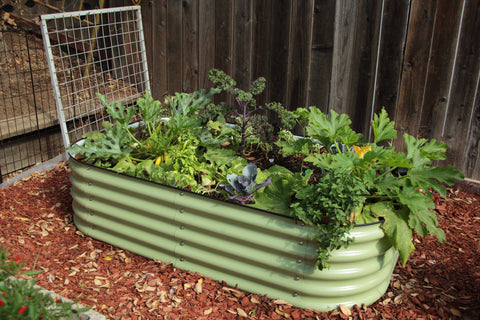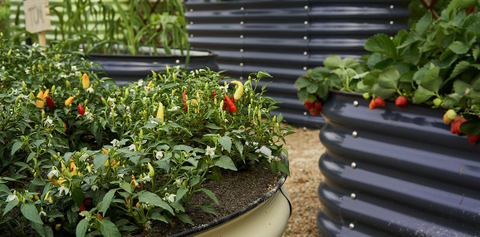Knowledge from Olle Garden Bed: Can You Eat Potato Leaves
Potato plants are solanum plants, which can produce edible tubers. Some people are curious about whether potato leaves can be eaten. The following content also has some reference value for raised garden beds.
So - can you eat potato leaves? Or - are they poisonous?

Can I eat potato leaves? Or toxic?
Don't eat potato leaves! Potato leaves and plant parts (except for actual potatoes) are not edible. They are poisonous, because they are solanaceous plants of Solanaceae, as well as pepper, eggplant, tomato and other plants. Although fruits are edible, leaves and plant parts can produce steroidal alkaloids, which may be harmful.
Although the leaves of potato plants are not technically toxic, they contain a high level of solanine, which may cause gastrointestinal discomfort. Solanine exists in all parts of potato plants, but it is most concentrated in the leaves and stems.
Solanine may not cause minor symptoms. However, heavy consumption can cause nausea, vomiting and diarrhea. Therefore, it is best to avoid eating the leaves of potato plants.
However, if you accidentally eat them, there is no need to panic! Instead, drink plenty of water and monitor symptoms. If they persist or deteriorate, contact a medical professional immediately.
Which part of the potato plant is poisonous?
When friends ask you if you can eat potato leaves, I tell them not to! Eat nothing but potatoes! Don't eat potato leaves, stems or bean sprouts. The reasons are as follows.
Potato plants are members of Solanaceae. Other eggplant vegetables include tomatoes, peppers and eggplants. Although the fruits of these plants are safe to eat, their leaves and stems are poisonous.
The toxicity of Solanum stems is due to their solanine content. Solanine is a toxic compound, which can cause gastrointestinal discomfort, headache and even paralysis.
The highest solanine concentration was found in the green leaves and stems of potatoes. Therefore, it is important to remove these before eating.
However, even a small amount of green skin may contain enough solanine to cause problems. For this reason, it is best to be extra cautious. Don't eat potatoes with green skin or pulp. Even if you cook them, solanine still exists.

Are potato vines poisonous?
The common potato (Solanum tuberosum) does not produce vines. However, the sweet potato plant (Ipomoea batatas) is a plant with vines in the morning glory family.
Many farmers like to plant ornamental sweet potato vines because they have attractive leaves and fragrant flowers. However, some gardeners may worry about whether these plants are poisonous.
Although it is true that all parts of sweet potato vines contain a small amount of toxins, in most cases, these toxin levels are usually insufficient to cause harm. (We also found an excellent study that showed the surprising nutritional composition of sweet potato leaves. They are full of fiber, protein and minerals!
The leaves and stems of plants contain the highest levels of toxins, while tubers (the edible parts of plants) have relatively low levels.
Humans must consume large quantities of these plants to experience any adverse effects. Watching sweet potato vines (usually) is considered safe for most people.
They are obviously different. I haven't seen anyone selling potato leaves in shops or vegetable markets. However, I often see the supply of sweet potato leaves - a common ingredient, especially in Asian style dishes.
Another vegetable I like is Kangkong, or cabbage. It is closely related to sweet potatoes (Ipomoea family) and is often sold on the market. Because it is closely related to sweet potato, it can also be called "potato leaf".
The leaves of cabbage are much thinner than those of sweet potatoes and potatoes. Sweet potato leaves form a heart shape. Potato leaves can be identified by multiple leaves per stem, and have a classic "leaf" shape.
Are potato leaves poisonous to animals?
One of the most important aspects of raising livestock is to ensure that they have access to a healthy diet.
Monitoring the safe eating habits of farm animals and cattle means keeping them away from plants that may be toxic to them, such as potato leaves. Do not feed spoiled potatoes or sun baked potatoes to livestock. Although potatoes are completely safe for livestock, their leaves contain solanine, which is a large number of harmful compounds.
Although animals can eat a small amount of solanine without adverse effects, consuming a large amount of solanine may be harmful. Even fatal.
Symptoms of solanine poisoning include gastrointestinal discomfort, lethargy, weakness and paralysis.
In order to ensure the safety of animals, please make sure to enclose any area where potatoes grow. You should also remove any potato leaves that fall into the pasture, as they can still be eaten by livestock.
If you suspect your animal has eaten potato leaves or any poisonous plants, it is important to seek veterinary care immediately. Animals usually recover completely through timely treatment.
What if you eat potato leaves?
Potato leaves are poisonous to humans and livestock. Poisons are distributed throughout the plant, but most concentrated in the leaves.
Symptoms of potato leaf poisoning include nausea, vomiting and diarrhea. In severe cases, it can lead to muscle weakness, paralysis and even death. If you suspect that you or someone you know has eaten potato leaves, it is important to seek medical help immediately.
Although there is no specific antidote for potato leaf poisoning, timely treatment can usually help reduce the severity of symptoms and improve the chances of full recovery.

How to handle potato leaves
Potato leaves are a common sight in gardens. But some farmers do not know how to deal with them. Since you can't eat potato leaves, how can you benefit from them? The method is as follows.
One option is to compost them. Potato leaves are rich in nutrients, which is helpful to improve the quality of compost. However, you should avoid adding too many potato leaves to the compost heap, as they can cause the compost to become too acidic.
Another option is to throw them away. It is perfectly possible to discard potato leaves. Many people find that this is the simplest way to dispose of potato leaves.
